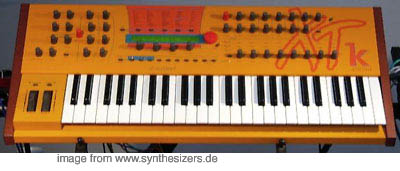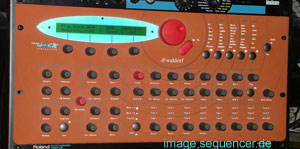WALDORF
Microwave XTk , Microwave XT Digital Synthesizer Waldorf
MicrowaveXTk/MicrowaveXT

pic shows the XTk has 49 keys. pic thx to ASSI
click image to enlarge - Bild klicken zum vergroessern
other WALDORF gear..
Built 1997
Type: digital
Hybrid: no
30 Voice / Stimmen
8x Multitimbral
large Memory / Speicher
Value / Wert in 2017 ca. 390 € (-)
Synthesis: wavetable
OSC Features digital waves in a table fm sync ring
Wave Shapes square saw triangle noise digital
2 OSCs
2 Filter lpf hpf bpf bit reduce filter fm self reso + hpf/lpf 1-4 Pole
2 LFOs pulse saw triangle sine s+h
4 Envelope Generators 2x ADSR 1x 8stage loop 1x 4stage
MIDI CONTROLLER Control / Triggering
49 Keys with external velocity pressure
Arpeggiator yes
Sequencer no
(ID 30)
Type: digital
Hybrid: no
30 Voice / Stimmen
8x Multitimbral
large Memory / Speicher
Value / Wert in 2017 ca. 390 € (-)
Synthesis: wavetable
OSC Features digital waves in a table fm sync ring
Wave Shapes square saw triangle noise digital
2 OSCs
2 Filter lpf hpf bpf bit reduce filter fm self reso + hpf/lpf 1-4 Pole
2 LFOs pulse saw triangle sine s+h
4 Envelope Generators 2x ADSR 1x 8stage loop 1x 4stage
MIDI CONTROLLER Control / Triggering
49 Keys with external velocity pressure
Arpeggiator yes
Sequencer no
(ID 30)


ABOUT the second release of the microwave but this time based on a DSP (digital only). now with knobs (thats the only difference to the Microwave 2). The idea of the Waldorf Microwave came, when us-musician Boddicker asked for a racked PPG Wave, so Wolfgang Düren took the liberty to make one, but newer and more modulation capabilities. The Masterpiece from Waldorf was the real successor of PPGs (Wolfgang Palm) Wavetable Synth "Wave 2.3" . well, about 90% of the Wave sounds could be made with the Microwave 2, but not as easy since editing Waves on the Wave is possible and much faster with knobs. therefore the XT came up. optional 10 or 30 voices.
ABOUT Die zweite Auflage des Microwave, diesmal aber komplett digital (Motorola DSP) und mit Knöpfen (der unterschied zum Microwave 2).Die Idee war, inspiriert vom US-Musiker Boddicker, eine Rackversion des legendären PPG Wave zu bauen, Wolfgang Düren nam das als erstes Projekt unter dem Namen Waldorf (ein kleiner Ort südlich von Bad Breisig (südl von Bonn) gerne an. Das Meisterstück von Waldorf war eine Luxusversion des Wave, der von Waldorf auf dem Prinzip des PPG Wave (von Wolfgang Palm) aufgebaut wurde und dazu: um alles erweitert, wo Geld keine Rolle spielt. Generell können zwar 90% aller Sounds (ohne HPF) auch mit dem Microwave gemacht werden, aber eben nicht so schnell. Die Waves können im Wave direkt auch editiert werden, was die Arbeit bequemer macht. Er bekam deutlich mehr Modulationsmöglichkeiten als der Original PPG sowie Modulation per spezieller Verknüpfungen (XOR,OR,AND etc..) in einer Modulationsmatrix.
ABOUT
DETAILS The Waves and Tables can be edited using software (sounddiver, p.pilgrims sooftware at soundtower) , so called UPAWs that are based on additive and FM offline tech , free ones can also be created (additive mixing, half waves mirrored) to be used in a wavetable. also a sample can be analyzed. of course it is not that "real" resynthesis but it is possible. The MicroWave does not offer PWM or sync but you can simulate it with Wavetables. nice 8stage Envelope for wavescanning! beside the 2 ADSRs for filter + amp it provides another free 4stage envelope! btw: there are about 1000 Waves. A Wavetable holds up to 60 Waves. there are 64 Preset Wavetables and 12 User-Wavetables. the early MW2 had less DSP RAM and therefore no delay, but it could be upgraded to 30 voices (10 was normal) AND the DSP RAM along with that. the XT was the same but with knobs.. filter: 24 pole filter, fm model bit reducer filter, and BPF with variable bandwidth. plus 6pole HPF/LPF.
DETAILS Die Waves und Tables können über einen Computer editiert werden und additiv bis FM berechnet werden und daraus eine Wavetable erstellt werden, dafür braucht man im Microwave Software, im Wave geht das direkt. Auch kann ein WAV File analysieren lassen und in Wavetables umrechnen lassen, die klingen sicher nicht so echt, aber es geht (ein bisschen Resynthese-Feelng). Der (Micro)Wave kann keine PWM, aber durch einen Wavetable kann man das simulieren, ebenso Sync-Sounds. coole 8stufige Hüllkurve für das Wavetable-durchfahren! Er hat noch eine weitere Free Envelope (4stufig) nebst der normalen ADSRs für Filter und Amp (ja, 4 Stück!). Übrigens bietet der Micro(Wave) auch abgefahrene Operationen, denn jeder Parameter hat ein oder mehrere Modulationeingänge, teilweise mit steuerung dieser Quelle über eine weitere (zB LFO tiefe über Modwheel). Die Waves können additive erstellt werden oder algorithmisch (UPAW) den Regeln der FM, Waveshaping, Sync etc. folgen. die gezeichneten Waves werden gespiegelt. Es handelt sich ja nicht um Samples, sondern um eine Halbwelle pro Wave, eine Wavetable hält 60 Waves aus einem Speicher von ca. 1000 Waves. Es gibt 64 Preset Wavetables und 12 User-Wavetables. Der XT kam später und hatte Knöpfe und etwas mehr DSP-RAM (für Delay Effekte), einige frühe MW2 haben das nicht. Optional: 10 oder 30 Stimmen. Software: Sounddiver oder Philip Pilgrims Software (gibts bei Soundtower, USA) filter: 24 poliger filter, fm modelle, bit reducer filter, und BPF mit variabler bandbreite. plus kleiner 6pol HPF/LPF.
DETAILS
SOUND very interesting digital Pads and evolving sounds that are very special, even very lofi loops. also basses and sick FM sounds.
SOUND der Microwave kann sehr abgefahrene Teppiche und Pads, sehr spezielle digitale Monstersounds. auch bässe und kranke FM sounds!
SOUND
VERSION old Microwave I with analogue filters : the latest OS 2. it added a lot. the waveslave was a knobless version (voice expander) but Waldorf offered to swap it for the OS2 into a real Microwave, so: it might be rare and works with OS 1-Microwaves only. Alternatively: Microwave 2 or XT: both are digital (no analog Filters) but more features like FM, Sync, Arper etc. the XT is the MW2 with knobs. 10 or 30 voices. earlier MW2 with less RAM: no delay! XT: no keyboard, XTk: with keyboard. XT was available in black (666 made -so it's been said- for a german distributor with old bigger knobs, the new series all got the longer Q-style knobs) latest OS: 2.33 (Xtk) 2.29 (XT).
The XTk (Keyboard) came in 1999, so much later - after the XT
The XTk (Keyboard) came in 1999, so much later - after the XT
VERSION Vorgänger mit analogen Filtern: Der Microwave I: das letzte OS war 2. es gibt mehrere Farben und die mean green machine: grün und mit netter beschriftung und raketenfüssen (boah!). es gab auch den waveslave ohne bedienelemente, der aber nur mit der 1er version läuft, es gab damals eine Tauschaktion zum Umbau auch für Waveslaves. Alternative: Der XT oder Microwave 2, ist jedoch ohne Analogfilter, hat aber mehr Möglichkeiten (FM, Sync, Arper, etc.) , der XT hatte Regler und war daher etwas höher. 10 oder 30 stimmen. letztes OS: 2.33 (Xtk) 2.29 (XT) XTk: mit keyboard XT: ohne keyboard. es gab schwarze XTs (stk: 666 sollen angeblich in Deutschland gebaut worden sein für einen bestimmten Händler mit breiten/alten Knöpfen, spätere hatten die länglichen Knöpfe, we sie auch im Q verwendet wurden) frühere MW2: hatten weniger DSP ram: kein delay!
Xtk kam 1999 auf den Markt, also deutlich später als der XT.
VERSION
Xtk kam 1999 auf den Markt, also deutlich später als der XT.


 AUDIO
AUDIO